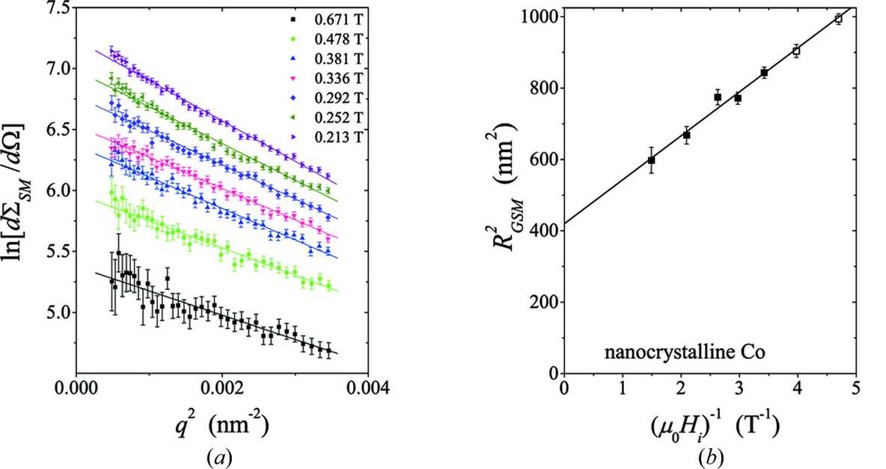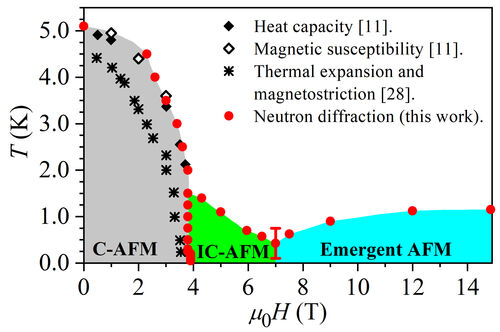Magnetism and superconductivity
Summary
The interactions of electrons in materials are a rich and complex source of physical problems, in part due to the issues brought about by dealing with the large number of electronic many-body interactions, both with other electrons and with the parent ions. These interactions give rise to fundamentally quantum mechanical states such as superconductivity and magnetism. New quantum states of matter are being uncovered on a regular basis.
We focus on using scattering techniques to look at the structure and dynamics associated with these strong electron corrrelations, particularly neutron and X-ray methods. To this end, we use a wide range of neutron facilities and synchrotron radiation facilities in Europe and around the world, soon to include the European Spallation Source at Lund. We also work on sample growth and characterizations using our lab facilities here.
Quantum magnetism
The electronic magnetic moment, and hence the atomic magnetic moment emerges from the combination of special relativity with quantum mechanics. In the solid state these individual magnetic moments may cooperate to generate a wide variety of macroscopic magnetic states. Some of these states shed light on the fundamentals of quantum mechanics; others find uses ranging from magnetic memory to fridges. We are working on a number of projects exploring novel magnetic arrangements and the excitations that define them.
Unconventional superconductivity
Superconductivity is an excellent example of an emergent phenomenon, where a macroscopic quantum state becomes energetically favourable below some critical temperature and field. When the mechanism pairing the electrons together remains in debate, superconductors are classed as unconventional. We have several projects ongoing in this area, including investigation of superconductivity in systems where the electrons are heavy, i.e. have a large effective mass, and explorations of the normal state from which superconductivity develops in the cuprate family of superconductors.
Studying magnetism with X-rays
X-rays interact with the electrons in matter, and are routinely used to establish the physical structure of materials, i.e. where the electrons in a given compound are spatially. The x-ray photons can also interact directly with the spin of the electrons, and so they can scatter off the magnetic structure. However, the cross-section for this interaction is very small, and usually impractical to measure unless one has a large amount of time or a large amount of photons. Modern synchrotron sources certainly provide the latter.
There is another trick for looking at both magnetism and more subtle electronic effects, which involves exploiting resonant effects. If the incident photon energy is just right, it can excite a core atomic electron into the valence band. This is useful for identifying particular elements, as each element has its own characteristic energies. If the material is magnetic, then the valence bands may be split (as in the Zeeman effect) and one becomes sensitive to the magnetization in the material.
The key experimental necessity to exploit this feature is the ability to select the desired incident photon energy, according to the content of a given sample. Fortunately, this is possible at synchrotron sources.
Neutron scattering at high pressures
New electronic phenomena are often first seen in extreme conditions, such as at high pressures and low temperatures. By probing the response of materials to these extreme conditions, it is sometimes possible to figure out how to reproduce these phenomena in friendlier environments. Applying pressure directly changes inter-atomic distances, and this affects the exchange pathways that determine the overall magnetic state. To measure the effects of high pressure using neutron scattering presents some difficulties, as relatively large samples are required to get a good signal-to-noise ratio, and because the pressure cells generate a lot of background scattering. We are working with collaborators at KTH (Patrik Henelius) and ESS (Pascale Deen, Malcolm Guthrie, Rasmus Toft-Petersen) to develop new uniaxial and hydrostatic pressure cells, optimized for neutron scattering at the ESS, on a project funded by VR.
Magnetic Guinier Law

Small angle scattering of X-rays and neutrons is routinely used to determine nanoparticle sizes. The low-q approximation for the small angle scattering curve from an assembly of particles is known as the Guinier law. It assumes a sharp interface between each particle and the surrounding matrix. This is not really true for the magnetism in nanoparticles. In this paper a 'magnetic' Guinier law is developed and tested using nanocrystalline cobalt. In the figure above, the left-hand plot shows the small-angle neutron scattering curves at different magnetic fields, which affect the sharpness of the interface. The right-hand plot shows the linear variation of the square of the magnetic Guinier radius versus the inverse of the magnetic field applied, as expected from this new magnetic Guinier law.
Publication
Magnetic Guinier Law. Andreas Michels, Artem Malyeyev, Ivan Titov, Dirk Honecker, Robert Cubitt, Elizabeth Blackburn and Kiyonori Suzuki, IUCrJ 7, 136-142 (2020).
Publication on the journal website of the International Union of Crystallography (IUCr)
Phase diagram of a quantum spin chain

In strontium cobalt vanadate (SCVO), the Co ions form chains that are isolated from each other. These chains can be modelled as 1-D objects. Such 1-D objects were predicted to have a variety of interesting properties - in the non-magnetic analogue, the electron breaks down into quasiparticles that carry the charge and the spin components separately. In SCVO, this has been shown to be the case. However, on cooling it down far enough, the interactions between the chains are no longer washed out. This causes the 1-D state to break down in interesting ways. Here, we have used neutron diffraction to establish the evolution of the magnetic order that develops at low temperatures and high magnetic fields, with the results summarized in the figure above. Our results show that interchain mean-field theory is insufficient to explain the observed features.
Publication
Magnetic phase diagram of the quantum spin chain compound SCVO: a single-crystal neutron diffraction study. L. Shen, O. Zaharko, J. O. Birk, E. Jellyman, Z. He and E. Blackburn, New Journal of Physics 21, 073014 (2019).
Interested in working with us?
Available BSc/Msc projects
We welcome candidates for BSc and MSc thesis.
PhD and PostDoc positions
When available published on Lund University's website. Direct contact is welcome.
